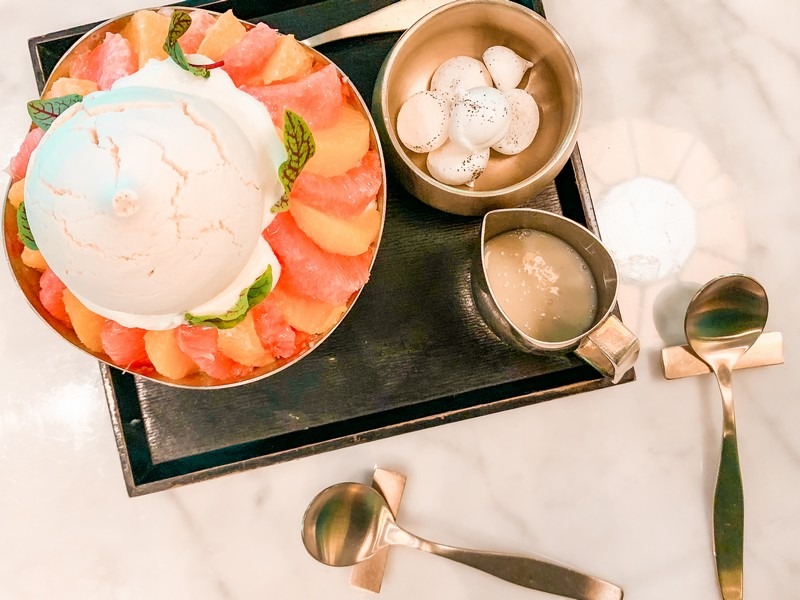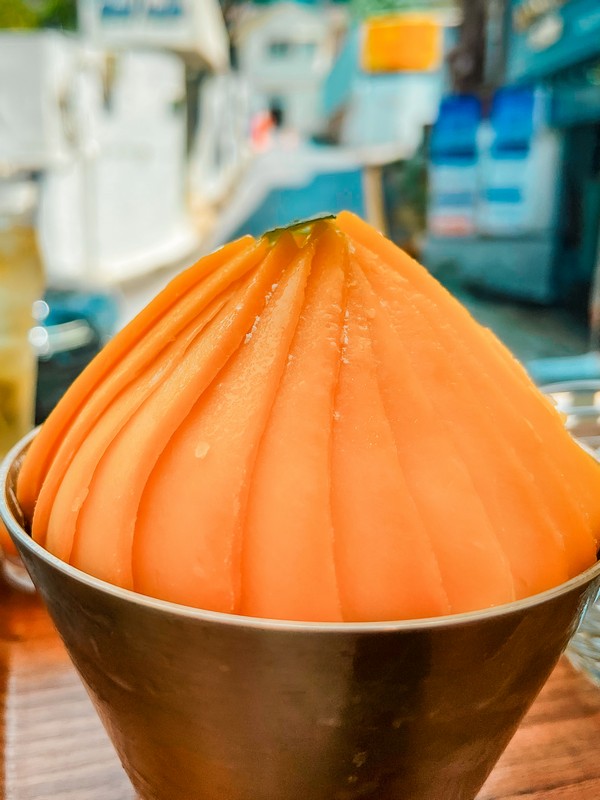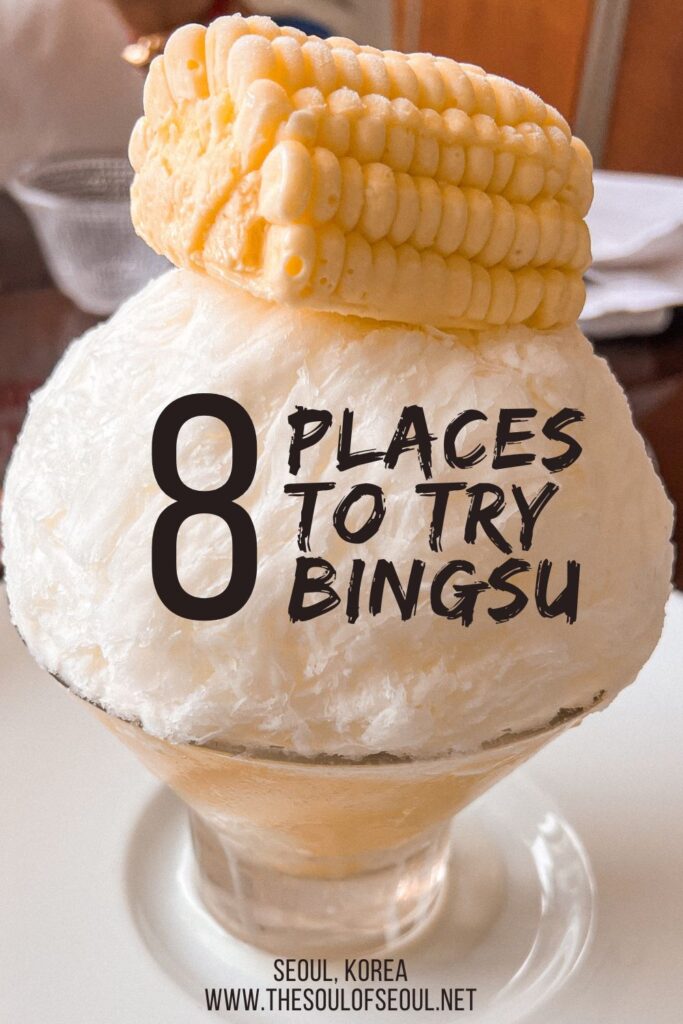Bingsu: The Korean Shaved Ice Dish You’ll Love
Last Updated on November 28, 2023
Bingsu, also sometimes spelled bingsoo, is a refreshing Korean dessert that is a summertime staple and has gained popularity worldwide thanks to Korean dramas and the Hallyu Wave. You won’t generally see it all year round, though there are some popular cafes that continue to offer the dish, it’s most popular in the summer in Korea and starts appearing on street food carts and in restaurants around late April and early May.
Bingsu has become so popular and has gone through quite the evolution even in just the past decade. With traditional options and now more trendy versions too, this is a part of Korean cuisine you’ll want to try.

Whether you want to learn what bingsu is, how to make it, or where to find bingsu in Seoul, I’ve got you covered:
- What is bingsu
- The history of bingsu
- The evolution of bingsu
- How much does bingsu cost in Korea?
- Popular bingsu varieties and flavors
- How to make bingsu
- Best bingsu spots in Seoul
(This post contains affiliate links, which means I receive a certain percentage of a sale if you purchase after clicking at no cost to you. Thank you for your support.)
What is bingsu
Bingsu (빙수) is a Korean shaved ice dish that is especially popular in the summer when it’s hot and humid and people need to cool off. The original and most traditional dish is patbingsu and is served with shaved ice topped with red bean, sweetened condensed milk, and Korean rice cake.

The history of bingsu
The origins of frozen treats can be traced back to ancient times, with early observations of shaved ice in China dating back to 3000 B.C. However, the emergence of bingsu in Korea can be credited to the Joseon era when royalty and the aristocracy enjoyed it with fruit toppings.
Originally a delicacy accessible only to the wealthy, the advent of refrigeration in the early 20th century made ice more accessible to the general public, leading to the availability of bingsu to a broader audience.

The evolution of bingsu
Originally a fairly basic ice and fruit dish, over the years, bingsu has undergone significant transformations, influenced by historical events and cultural exchanges.
The more modern versions of bingsu came about after the Korean War when US soldiers brought in condensed milk which made the fruity shaved ice dish richer in flavor.
In the 1980s, the dish was again reborn as “patbingsu (팥빙수)”; sweet red beans, rice cakes, and jelly became common toppings for the shaved ice dish.
In the 2000s, the addition of milk to the ice created a soft, snowflake-like texture, and bingsu evolved further with the incorporation of high-quality and imported fruits, nuts, and ice cream as delectable toppings. Today, you can find this treat everywhere from street food stalls to cafes that are devoted to the treat.

How much does bingsu cost in Korea?
While bingsu is generally a very budget-friendly treat for locals and costs between W8,000 and W15,000, there are some specialty shops and luxury hotels that offer the dish for top dollar. The Four Seasons Hotel in Seoul often takes the prize for the most expensive bingsu in Korea. At their restaurant, Maru, they offer seasonal bingsu options that change monthly throughout the summer.
We tried their Citrus Pavlova Bingsu and it was amazing and at W126,000, it should be. I should add that The Four Seasons makes a larger bingsu offering that is meant to feed three to four people so go with friends or family to eat it. Outside, you’ll generally find the dish fitting for one to two people in size so this is larger than most.



Popular bingsu varieties and flavors
The possibilities are endless, and creative twists continue to emerge, making bingsu an exciting and diverse dessert. Start with the traditional patbingsu and go from there. You can add everything from fruits to coffee, matcha, and chocolate.
Patbingsu (팥빙수): The most common variety of bingsu is patbingsu, featuring red bean paste, condensed milk, rice cake squares, and misugaru (a roasted grain powder).
Matcha bingsu (녹차 빙수): A variation of bingsu that is infused with green tea flavor, topped with green tea powder, mochi, and sweetened red beans.
Strawberry bingsu (딸기 빙수): A delightful variation of bingsu that has, at the same would suggest, fresh strawberries, strawberry syrup, and sometimes accompanied by strawberry ice cream.
Mango bingsu (망고 빙수): This is one of our favorites. A tropical variation of bingsu that uses mango chunks or slices, mango syrup, and a scoop of ice cream sometimes as well.
How to make bingsu
For those unable to find bingsu nearby, creating this frozen delight at home is an enticing option. Look into getting an ice shaver and see if you can find one in your area. There’s the nice Yescom 300W Electric Ice Shaver on Amazon as well as a cheaper more portable ALLOMN grinder.
Bingsu recipes abound, offering a chance to explore various toppings and flavors. Traditional toppings like sweet red bean paste, rice cakes, and groundnut powder can be complemented with fresh fruits, condensed milk, candy, or cookies, allowing for endless customizations.
What to prepare
What to prepare depends on what variety of bingsu you’ll be making. Here’s a good list to start with but pick and choose depending on what you want.
- Milk
- Sweetened condensed milk
- Bingsu tteok (빙수떡)
- Also called mini mochi rice cakes, these are sweet rice cakes that add a chewy texture to this sweet dish.
- Red beans (팥) (for patbingsu)
- Misugaru (미숫가루) (for patbingsu)
- This is a powder made from several roasted grains like sweet rice, brown rice, barley, soy beans, sorghum, black beans and Job’s tears which are roasted and made into powder.
Bingsu recipe
- At least five hours before you want the dish, freeze a mixture of whole milk and sweetened condensed milk in an ice tray. The mixture is 1 cup of milk to 2 tablespoons of sweetened condensed milk. That’s good for a small dessert dish. You’ll want about four times that for a standard Korean serving size of bingsu. You can also use regular ice but the milk ice makes a nicer texture and taste.
- Prep the toppings that you’ll want to use first. Once the ice is ready, the dish will come together pretty quickly so do be prepared.
- Using an electric ice shaver, you can create the fluffy texture of bingsu right at home. You can also use a high-speed blender, but you’ll want to add the ice in batches so you don’t dull the blades and the texture won’t be quite the same though it’ll work in a pinch.
- Put the shaved ice into a chilled bowl and then add the toppings.
- For patbingsu: Add 2-3 tablespoons of red beans and drizzle 1-2 tablespoons of sweetened condensed milk on top. Top with a few chunks of rice cake.
- For matcha bingsu: Add 2-3 tablespoons of red beans and drizzle 1-2 tablespoons of sweetened condensed milk and 2 tablespoons of matcha syrup on top. Top with a few chunks of rice cake and green tea ice cream.
- For strawberry/mango bingsu: Add as many fruity slices and chunks as you like and drizzle 1-2 tablespoons of sweetened condensed milk on top.

Best bingsu spots in Seoul
Come summer you can find bingsu offered in a ton of places that don’t normally serve the dish as it is generally just a summer-time food. That said, because the popularity of the dish has grown in recent decades, there are now also cafes that cater to the bingsu-lovers year round. Here’s where to find the best bingsu in Seoul.
- Sulbing (설빙): One of the largest dessert cafe chains in Korea that caters to bingsu-lovers. They have a year round menu of bingsu available but also have seasonal options that change with the weather. They have more than 500 stores in South Korea so just search “설빙” on your favorite navigation tool and see which one is closest to you.
- Tokyo Bingsu (도쿄빙수): Coming in hot from Japan, this bingsu company also have various branches around the city and they have some pretty fun flavors like tomato of all things. I’ve heard it’s pretty good though. Just search “도쿄빙수” on your navigation tool because there are a number of them around now.
- Maru at The Four Seasons: As mentioned above, the most expensive bingsu in the country is served at The Four Season’s in house restaurant Maru. They serve their dish seasonally and each month from May through August they change the bingsu on offer. Made to serve 3-4 people, go with friends. It’s amazingly delicious.
- Address: 97 Saemunan-ro, Jongno-gu, Seoul (서울 종로구 새문안로 97)
- Colline Cafe (콜린카페): Colline Cafe is one of the only places in Seoul that you’ll be able to find flowers year round. This beautiful cafe that we’ve gone to often for a “cloud” topped coffee surrounded by flowers also serves a delicious bingsu in the summer months. This is one of the best cafes in Hongdae year round.
- Address: 45-1 Eoulmadang-ro, Seogyo-dong, Mapo-gu, Seoul (서울 마포구 어울마당로 45)
- Hours: Every day: 10:30am ~ 11:00pm


- Maison De La Categorie (메종드라카테고리): I had the funniest bingsu experience of my life here. This chic bistro in Cheongdam-dong serves French cuisine and for dessert… corn bingsu! Yes, you heard me right. Corn! It’s a must see for the sheer humor. Surprisingly good though.
- Address: 85 Cheongdam-dong, Gangnam-gu, Seoul (서울 강남구 선릉로 826)
- Hours: Tuesday – Sunday: 11:00am ~ 10:00pm (Break time: 5:00pm ~ 5:30pm)
- JW Marriott Dongdaemun: Another hotel that cools off patrons with bingsu in the summer is JW Marriott Dongdaemun which offers a number of specialty bingsus each summer that are not only delicious but are visually stunning. One year they Dongdaemun Gate out of chocolate to top their bowls. Amazing!
- Address: 279 Cheonggyecheon-ro, Jongno-gu, Seoul
- Hours: Every day: 10:00am ~ 8:00pm
- Samcheong Bingsu (삼청빙수): This bingsu cafe sits in a beautiful Hanok in Bukchon and serves a variety of popular bingsu flavors of course starting with the classic patbingsu but also serving some fruity fresh options too.
- Address: 84-1 Samcheong-ro, Jongno-gu, Seoul (서울 종로구 삼청로 84-1)
- Hours: Every day: 12:00pm ~ 8:00pm
- Suyeonsanbang (수연산방): This is a famous bingsu tea house that serves sweet pumpkin bingsu but more than that, the Hanok was where the famous Korean writer Lee Tae Jun (이태준) lived from 1933 until 1946. The tea house has been designated as a Seoul City Folk Material.
- Address: 8 Seongbuk-ro 26-gil, Seongbuk-gu, Seoul (서울 성북구 성북로26길 8)
- Hours: Wednesday – Friday: 11:30am ~ 6:00pm; Saturday – Sunday: 11:30am ~ 10:00pm
From its humble origins enjoyed by the elite to a beloved summertime treat for all, bingsu’s journey reflects cultural exchange, innovation, and global appreciation. Whether savoring traditional patbingsu or indulging in modern, creative flavors like corn and tomato, bingsu continues to bring joy and refreshment to those who savor its sweet delights. Get eating!
Did you like this post? Pin it!




2 Comments
Trey Hoffman
These are great images of Bingsu. Can I ask if they are copyrighted or are free for me to use in our product literature?
Hallie Bradley
No, you cannot use these in your product literature. Thank you for asking.